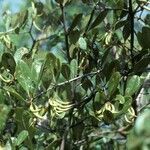Plants ca. 1.5 m tall. Branchlets reddish or blackish brown, glabrous. Petiole 5-10 mm; leaf blade elliptic or broadly obovate, 3-8 × 2-4.5 cm, leathery, base cuneate, margin entire, revolute, apex rounded or emarginate; lateral veins 7-11 on each side of midrib, densely puberulent abaxially. Inflorescences terminal, subsessile, ca. 10-flowered; bracts oblong-lanceolate, deciduous. Pedicel ca. 1 cm, ± glandular. Flowers ca. 1 cm. Calyx lobes rhomboid, 5-6 × 3-4 mm, leathery, prominently veined, black glandular at base, asymmetric, entire, apex broadly rounded. Corolla white, ca. 9 mm; lobes ovate, ca. 5 mm, asymmetric, acuminate, reflexed; tube 3-4 mm, villous inside. Stamens longer than corolla tube; filaments villous basally on outside, glabrous inside; anthers ca. 3 mm. Style black glandular basally. Fruit 6(-8) cm, 5-6 mm in diam., glabrous, base clasped by twisted persistent sepals. Fl. Dec-Feb, fr. Oct-Dec.
A small tree or shrub. It grows up to 1.5-7 m tall. It often has several stems. The young branches are reddish brown. The bark is smooth and grey to brown. The leaf stalk is 5-10 mm long. The leaves are oval. They are 2.5-8.5 cm long by 0.9-3.6 cm wide. They are leathery. There are 7-11 side veins on each side of the main vein. The midrib is easily seen under the leaf. The flower arrangement is made up of flowers from a common point arranged on stalks of equal length. They arise from a knob like point. The fruit are curved and like a cylinder up to 8 cm long by 5-6 mm across. They taper to a sharp point.


